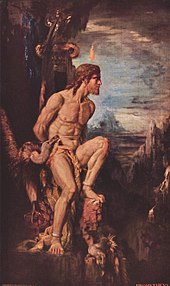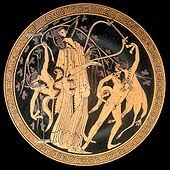"Myths of origin" or "creation myths" represent an attempt to render the universe comprehensible in human terms and explain the origin of the world. The most widely accepted version at the time, although a philosophical account of the beginning of things, is reported by Hesiod, in his Theogony. He begins with Chaos, a yawning nothingness. Out of the void emerged Eurynome, Gê or Gaia (the Earth) and some other primary divine beings: Eros (Love), the Abyss (the Tartarus), and the Erebus. Without male assistance, Gaia gave birth to Oranos (the Sky) who then fertilized her. From that union were born first the Titans—six males: Coeus, Crius, Cronus, Hyperion, Iapetus, and Oceanus; and six females: Mnemosyne, Phoebe, Rhea, Theia, Themis, and Tethys. After Cronus was born, Gaia and Oranos decreed no more Titans were to be born. They were followed by the one-eyed Cyclopes and the Hecatonchires or Hundred-Handed Ones. Cronus ("the wily, youngest and most terrible of Gaia's children") castrated his father and became the ruler of the gods with his sister-wife Rhea as his consort, and the other Titans became his court.
A motif of father-against-son conflict was repeated when Cronus was confronted by his son, Zeus. Because Cronus had betrayed his father, he feared that his offspring would do the same, and so each time Rhea gave birth, he snatched up the child and ate it. Rhea hated this and tricked him by hiding Zeus and wrapping a stone in a baby's blanket, which Cronus ate. When Zeus was grown, he fed his father a drugged drink which caused Cronus to vomit, throwing up Rhea's other children and the stone, which had been sitting in Cronus' stomach all along. Then Zeus challenged Cronus to war for the kingship of the gods. At last, with the help of the Cyclopes (whom Zeus freed from Tartarus), Zeus and his siblings were victorious, while Cronus and the Titans were hurled down to imprisonment in Tartarus.
Zeus was plagued by the same concern and, after a prophecy that the offspring of his first wife, Metis, would give birth to a god "greater than he"—Zeus swallowed her. She was already pregnant with Athene, however, and they made him miserable until Athene burst forth from his head—fully-grown and dressed for war. This "rebirth" from Zeus was used as an excuse for why he was not "superseded" by a child of the next generation of gods, but accounted for the presence of Athene. It is likely that cultural changes already in progress absorbed the long-standing local cult of Athene at Athens into the changing Olympic pantheon without conflict because it could not be overcome.

The earliest Greek thought about poetry considered the theogonies to be the prototypical poetic genre—the prototypical mythos—and imputed almost magical powers to it. Orpheus, the archetypal poet, also was the archetypal singer of theogonies, which he uses to calm seas and storms in Apollonius' Argonautica, and to move the stony hearts of the underworld gods in his descent to Hades. When Hermes invents the lyre in the Homeric Hymn to Hermes, the first thing he does is sing about the birth of the gods. Hesiod's Theogony is not only the fullest surviving account of the gods, but also the fullest surviving account of the archaic poet's function, with its long preliminary invocation to the Muses. Theogony also was the subject of many lost poems, including those attributed to Orpheus, Musaeus, Epimenides, Abaris, and other legendary seers, which were used in private ritual purifications and mystery-rites. There are indications that Plato was familiar with some version of the Orphic theogony. A silence would have been expected about religious rites and beliefs, however, and that nature of the culture would not have been reported by members of the society while the beliefs were held. After they ceased to become religious beliefs, few would have known the rites and rituals. Allusions often existed, however, to aspects that were quite public.
Images existed on pottery and religious artwork that were interpreted and more likely, misinterpreted in many diverse myths and tales. A few fragments of these works survive in quotations by Neoplatonist philosophers and recently unearthed papyrus scraps. One of these scraps, the Derveni Papyrus now proves that at least in the fifth century BC a theogonic-cosmogonic poem of Orpheus was in existence. This poem attempted to outdo Hesiod's Theogony and the genealogy of the gods was extended back to Nyx (Night) as an ultimate female beginning before Eurynome, Uranus, Cronus, and Zeus. Night and Darkness could equate with Chaos.
The first philosophical cosmologists reacted against, or sometimes built upon, popular mythical conceptions that had existed in the Greek world for some time. Some of these popular conceptions can be gleaned from the poetry of Homer and Hesiod. In Homer, the Earth was viewed as a flat disk afloat on the river of Oceanus and overlooked by a hemispherical sky with sun, moon, and stars. The Sun (Helios) traversed the heavens as a charioteer and sailed around the Earth in a golden bowl at night. Sun, earth, heaven, rivers, and winds could be addressed in prayers and called to witness oaths. Natural fissures were popularly regarded as entrances to the subterranean house of Hades and his predecessors, home of the dead. Influences from other cultures always afforded new themes.



Nema komentara:
Objavi komentar